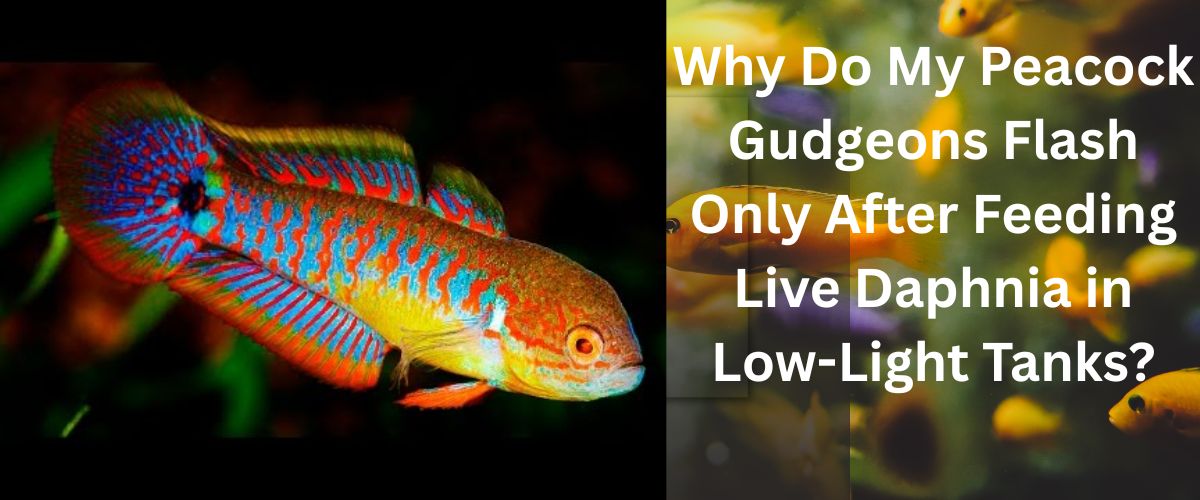Peacock Gudgeons (Tateurndina ocellicauda) are renowned for their vibrant colors and peaceful demeanor, making them a favorite among freshwater aquarium enthusiasts. However, some aquarists have observed a peculiar behavior: these fish begin to flash—rubbing or gliding against surfaces—specifically after consuming live daphnia in low-light conditions. Understanding this behavior is crucial to ensure the health and comfort of your aquatic pets.
Understanding Flashing Behavior
What is Flashing?
Flashing refers to a fish rapidly rubbing its body against objects in the aquarium, such as rocks, plants, or substrate. This behavior can be a response to various stimuli, including:
- Irritation from parasites or external factors.
- Reaction to water quality issues.
- Natural behavior during certain activities, like feeding or breeding.
Is Flashing Always a Sign of Illness?
Not necessarily. While flashing can indicate discomfort or health issues, it can also be a temporary response to environmental changes or specific stimuli. The context and frequency of the behavior are essential in determining its cause.
Potential Causes of Post-Feeding Flashing in Low-Light Conditions
1. Reaction to Live Daphnia
Live daphnia are a nutritious food source, rich in protein and beneficial for fish health. However, they can sometimes carry parasites or bacteria, especially if sourced from unreliable suppliers. Ingesting contaminated daphnia might cause temporary irritation, leading to flashing behavior.
2. Sensory Overload in Low-Light
Peacock Gudgeons are visual feeders. In dim lighting, their ability to perceive movement and distinguish prey diminishes. Feeding in such conditions might cause stress or confusion, leading to atypical behaviors like flashing.
3. Water Quality Fluctuations
Feeding live foods can introduce organic waste into the aquarium, affecting water parameters. In low-light conditions, photosynthesis in plants decreases, potentially reducing oxygen levels. Combined, these factors might cause temporary discomfort, prompting flashing.
4. Natural Behavioral Response
Some fish exhibit increased activity or specific behaviors after feeding, especially when consuming live prey. The excitement or stimulation from hunting live daphnia might trigger natural behaviors, including flashing.
Investigating the Behavior
Observation Tips:
- Monitor the frequency and duration of the flashing.
- Note if the behavior occurs exclusively after feeding live daphnia or also with other foods.
- Check if the behavior persists in different lighting conditions.
Water Testing:
Regularly test water parameters, focusing on:
- Ammonia, nitrite, and nitrate levels.
- pH and hardness.
- Oxygen levels, especially after feeding.
Health Assessment:
Inspect your Peacock Gudgeons for signs of illness:
- Visible parasites or lesions.
- Clamped fins or lethargy.
- Loss of appetite or changes in coloration.
Solutions and Preventative Measures
1. Ensure Quality of Live Food
- Source live daphnia from reputable suppliers.
- Consider quarantining live food before feeding.
- Rinse live food thoroughly to remove potential contaminants.
2. Adjust Feeding Practices
- Feed during periods of natural or adequate artificial lighting.
- Introduce live food gradually to monitor reactions.
- Alternate with frozen or freeze-dried daphnia to reduce potential risks.
3. Maintain Optimal Water Quality
- Perform regular water changes to keep parameters stable.
- Avoid overfeeding to reduce organic waste buildup.
- Ensure proper filtration and aeration, especially after feeding.
4. Enhance Tank Environment
- Provide hiding spots and plants to reduce stress.
- Maintain consistent lighting schedules to establish routine.
- Monitor tank mates to ensure compatibility and reduce potential stressors.
Conclusion
Flashing behavior in Peacock Gudgeons after consuming live daphnia in low-light conditions can stem from various factors, including reactions to live food, environmental stressors, or natural behavioral responses. By observing your fish, maintaining optimal tank conditions, and ensuring the quality of food sources, you can mitigate this behavior and promote a healthy, stress-free environment for your aquatic pets.
References
- PetMeDaily. (n.d.). Peacock Gudgeon: Care, Feeding, Diet, and Breeding. Retrieved from https://petmedaily.com/peacock-gudgeon/
- Aquarium Friend. (n.d.). Peacock Gudgeon 101: Tank Requirements, Feeding, Tank Mates & More!. Retrieved from https://aquariumfriend.com/caring-for-peacock-gudgeon/
- Fishkeeping World. (n.d.). The Complete Guide to Peacock Gudgeon Care. Retrieved from https://www.fishkeepingworld.com/peacock-gudgeon/
- Reddit. (n.d.). Peacock Gudgeons Feeding Advice. Retrieved from https://www.reddit.com/r/Aquariums/comments/o278gu/peacock_gudgeons_feeding_advice/

